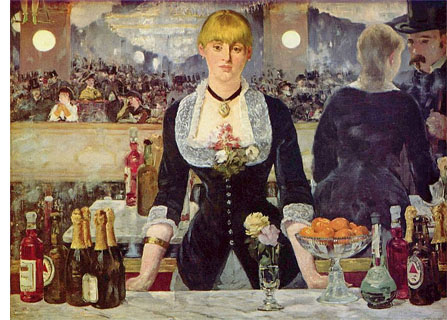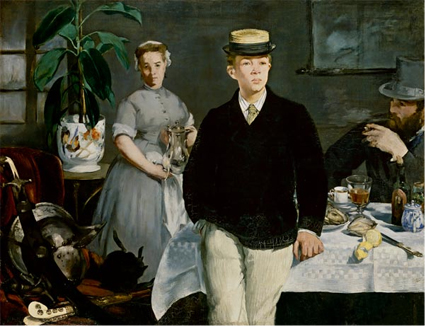“Manet Face to Face”, at the Courtauld Institute Galleries, is a refreshingly minimal exhibition. The exact opposite of a blockbuster, it consists of just two great paintings by the same great artist, hung opposite one another in a single and otherwise empty room (empty, that is to say, save for a few wall texts of varying lucidity). Manet’s intriguingly unconventional conversation painting, The Luncheon of 1868, has been loaned by the Neue Pinakothek in Munich. It faces the Courtauld Institute’s own masterpiece of Manet’s last years, A Bar at the Folies-Bergere, of 1881-2.
 The pictures differ greatly from one another in style. The handling and predominantly grey-black palette of the earlier work seem almost ascetically sober by contrast with the light tonality, flickering brushwork and multiple accents of bright colour of A Bar at the Folies-Bergere, in which Manet – influenced perhaps by the work of some of his younger contemporaries, who had taken to calling themselves “Impressionists” – sought to evoke the brittle, glittering world of a fashionable Parisian café-concert. But the paintings have much in common too. Each presents a scene from contemporary life framed with disconcerting immediacy.
The pictures differ greatly from one another in style. The handling and predominantly grey-black palette of the earlier work seem almost ascetically sober by contrast with the light tonality, flickering brushwork and multiple accents of bright colour of A Bar at the Folies-Bergere, in which Manet – influenced perhaps by the work of some of his younger contemporaries, who had taken to calling themselves “Impressionists” – sought to evoke the brittle, glittering world of a fashionable Parisian café-concert. But the paintings have much in common too. Each presents a scene from contemporary life framed with disconcerting immediacy.
Each is shot through with a sense of unease and shadowed by mystery. And each was painted to be shown in the public forum of the Paris Salon, “the only battlefield that counts,” in Manet’s view, where pictures were hung in serried rows, many of them high above eye level, according to the alphabetical order of the exhibiting artists’ names. Manet has, in both cases, treated the apparently slight subject matter of genre painting on a nearly monumental scale. For each picture he has also adopted a boldly unconventional composition, dominated by a single looming figure, cut off by the bottom of the frame. This was perhaps...

Manet: Face to Face at the Courtauld Institute Gallery 2004
21-11-2004

